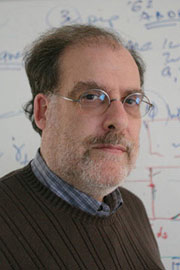
Handy Links
SLAC News Center
SLAC Today
- Subscribe
- Archives: Feb 2006-May 20, 2011
- Archives: May 23, 2011 and later
- Submit Feedback or Story Ideas
- About SLAC Today
SLAC News
Lab News
- Interactions
- Lightsources.org
- ILC NewsLine
- Int'l Science Grid This Week
- Fermilab Today
- Berkeley Lab News
- @brookhaven TODAY
- DOE Pulse
- CERN Courier
- DESY inForm
- US / LHC
SLAC Links
- Emergency
- Safety
- Policy Repository
- Site Entry Form

- Site Maps
- M & O Review
- Computing Status & Calendar
- SLAC Colloquium
- SLACspeak
- SLACspace
- SLAC Logo
- Café Menu
- Flea Market
- Web E-mail
- Marguerite Shuttle
- Discount Commuter Passes
-
Award Reporting Form
- SPIRES
- SciDoc
- Activity Groups
- Library
Stanford
Around the Bay
From the PPA Director: BaBar's Shortened Run
 As you all know, one of the consequences of the budget cut we face here at SLAC is the early conclusion of the B-factory run. Persis mentioned in her all-hands meeting that BaBar started operating in a different mode just before Christmas to make the most of the shortened run. The PEP-II accelerator team and BaBar physicists have put in a huge effort to adjust their program so rapidly to the changes imposed on us and it is testimony to their resourcefulness that this plan could be implemented so quickly.
As you all know, one of the consequences of the budget cut we face here at SLAC is the early conclusion of the B-factory run. Persis mentioned in her all-hands meeting that BaBar started operating in a different mode just before Christmas to make the most of the shortened run. The PEP-II accelerator team and BaBar physicists have put in a huge effort to adjust their program so rapidly to the changes imposed on us and it is testimony to their resourcefulness that this plan could be implemented so quickly.
BaBar has made great contributions to particle physics and will continue to do so through the final part of its experimental run and subsequent analysis. The new plan for BaBar is designed to extract the maximum amount of physics possible in the remaining running time. Although the plan differs from the collaboration's original intentions, we anticipate a lot of interesting and significant results.
The essential difference with the new running mode is that BaBar will operate at a slightly lower energy, one that corresponds to the creation of a particle called the Upsilon(3S). It is made of a bottom quark and an anti-bottom quark bound together in an excited state. Although pushing the energy frontier is always useful in particle physics, running at lower-than-frontier energies sometimes allows for different kinds of investigations that can't easily be performed at full energy.
Lower energy searches are particularly useful when a large new data set can be created and BaBar will be able to collect ten times more data at this energy than any previous experiment. BaBar will collect about 100 million Upsilon(3S) decays during its final run. The large data set will give vital hints as to the locations of new particles and the physics that governs them, or even discover new exotic physics.
For example, BaBar's new searches will compare the frequencies of various types of decays with those predicted by the Standard Model of particle physics. Some theories of supersymmetry predict the existence of exotic new particles that could be the missing dark matter while others even predict a very light Higgs particle. BaBar could potentially detect or infer their presence if they exist and has the resolving power to rule out a large set of theories if they don't. BaBar will also perform a sensitive test of one of the fundamental assumptions of the Standard Model, called lepton universality. It predicts that the force-carrying particles like the photon, W and Z don't distinguish between the electron, muon and tau in interactions. Much progress is made in physics by making sensitive tests of our assumptions, and in this case a subtle difference would be a strong sign of new physics.
The other main thrust of the BaBar research in this run will be "bottomonium" spectroscopy. Bottomonium is the general name for the set of particles that contain both a bottom quark and an anti-bottom quark, but are bound together with different energies. Upsilon(3S) is an example. Some of the bottomonium species have been predicted but never observed, and many other aspects of their behavior are still to be revealed. Measurement of the complete spectrum of the bottomonium system is critical input to lattice QCD, the computational theory of the strong force that exists between quarks. These measurements will also provide a host of checks of theoretical predictions for the kinds of particles observed by BaBar.
In all, the physics program for BaBar's final run remains strong, despite the very substantial losses associated with a shortened run. We are making the most of our options. This new Upsilon(3S) physics is valuable, and when combined with the existing Upsilon(4S) data, will occupy the BaBar collaboration for years, producing results that will continue to answer our most fundamental scientific questions.
—Steve Kahn, SLAC Today, January 11, 2008
Steve Kahn is SLAC's Director of Particle Physics and Astrophysics (PPA).